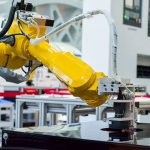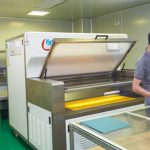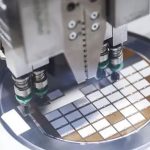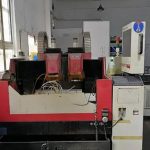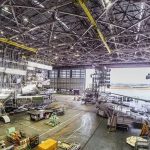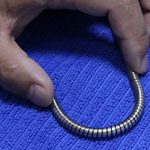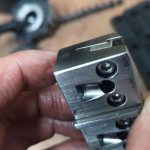Deprecated: get_settings is deprecated since version 2.1.0! Use get_option() instead. in /www/sites/alloy.wiki/index/wp-includes/functions.php on line 4862
In the process of the development of CNC technology in my country, the scarcity of CNC technical talents has always been an important restrictive factor. At present, the demand for numerical control technical talents in enterprises is increasing year by year, and the mechanical departments of various colleges and universities will also cultivate numerical control technical talents as an important direction of professional construction. Shazhou Vocational Institute of Technology, as a county-run vocational university for township enterprises, how to determine practical professional implementation plans and formulate reasonable theoretical and practical teaching plans based on the specific objects it serves, based on existing conditions, and formulate reasonable theoretical and practical teaching plans Necessary. This article analyzes the necessity of professional setting, the level and direction of talent training, and puts forward ideas for curriculum setting and teaching content for all colleagues.
1 The necessity of setting up a major in numerical control technology The machinery industry is the pillar and basic industry of the country’s economic construction and social development. Since the birth of CNC machine tools in the Massachusetts Institute of Technology in 1952, the mechanical manufacturing industry has begun to enter the era of flexible automation. The development of numerical control technology profoundly affects the development of mechanical technology, and the level of numerical control technology also marks the manufacturing level of all countries in the world. At present, the average level of numerical control in industrialized countries is 25%, and the proportion of numerical control equipment in my country is only about 2%. There is a considerable gap, and the potential market demand is quite huge. In order to shorten the gap between my country’s manufacturing industry and developed industrial countries as soon as possible, the Ministry of Machinery Industry of the People’s Republic of China regards the research and popularization and application of CNC technology as an important direction for the development of my country’s machinery manufacturing industry in the 21st century. The State Education Commission also regards numerical control technology education innovation as an important means of teaching reform for mechanical majors. Huangshan “Engineering Majors and Curriculum Reform Seminar” in August 1998
The above, clearly pointed out that the knowledge field of the mechanical discipline has developed from “pure machinery” to “the three-part world of mechanics, electricity and computers”. In October 1998, it was jointly organized by the State Education Commission, the Ministry of Machinery Industry and Huazhong University of Science and Technology in Wuhan. The seminar of “Numerical Control Technology Education Innovation Project” shows that the development of CNC technology profession plays an important role in the reform of mechanical profession in the 21st century.
Zhangjiagang City is located in the core area of the developed areas in southern Jiangsu. Township and village enterprises have started in the late 1970s, especially after entering the 1990s, they have developed rapidly, and have developed in the direction of increasing scale and higher grades. More than 300 large-scale technology-intensive enterprises have been formed. Among the 500 largest private enterprises in the country, there are 7 in Zhangjiagang City, 90 with fixed assets exceeding 50 million yuan, 10 with more than 100 million yuan, and 1,400 foreign-funded enterprises. Among them, machinery, molds, automobiles, textile machinery, steel and other industries occupy the largest proportion. Quite a few companies have introduced advanced CNC equipment and flexible manufacturing systems at home and abroad, and many companies have applied CAD design technology. For example, Qingzhou Group (Taiwan-owned) mainly produces motorcycle reducers (with an annual output of 300,000 sets), and Shunde Industrial (Taiwan-owned) produces molds. Most of the processes of the two companies use numerical control equipment to form a flexible manufacturing line. Tangqiao Town Yinhe Group is my country’s largest manufacturer of computer case power supplies. It provides supporting production for Lenovo, Founder, Shida and other computer manufacturers. It uses 3D CAD aided design in product design and uses machining centers for mold processing. CAD/CAM-integrated production method.
Shazhou Vocational College of Technology is the country’s first county-level city-run university. It mainly serves township and village enterprises in Zhangjiagang and surrounding areas. More than 80% of its graduates work in township and village enterprises. After several years of training, most of the students have become the technical backbone of the enterprise. Among the annual technological reform achievements of Zhangjiagang City, more than 40% are completed independently or presided over by the graduates of the school.
In recent years, with the development of numerical control technology and equipment of various enterprises, the lack of talents has become the bottleneck of technological development. On the one hand, the advanced equipment of the enterprise cannot fully play its role due to the shortage of talents. On the other hand, the scarcity of talents mastering CNC technology prevents the enterprise from boldly carrying out technological transformations.
From the analysis of the current demand for talents and the trend of local economic development, sorted by the nature of the work that graduates will be engaged in and the percentage of demand, the results are as follows: operation and maintenance of CNC machine tools (about 25%), process equipment design ( About 15%), the preparation of mechanism technology (about 15%), enterprise management (about 15%), product sales (about 15%), new product development (about 5%), and others based on the above data analysis, in order to meet the needs of enterprises As soon as possible to train the corresponding numerical control technical talents has become our top priority, and it is also imperative to set up and develop our school’s numerical control technology major. 2 Levels and goals of numerical control technical personnel training According to the laws and needs of technological development, numerical control technical personnel are the same as other technical personnel. The training of talents is divided into levels according to different needs. Due to the complexity of CNC technology, generally speaking, CNC technical talents can be divided into 5 levels, as explained below: Operation application layer: This level of talents is equivalent to technical operators, and they must master the operation of CNC machine tools and general programming. The CNC machining process and common tools of specific parts directly operate and use specific machine tools and systems. In the context of the increasing maturity of modern computer numerical control technology, it is also necessary to master computer-aided design and programming technology. The demand for talents at this level is the largest, accounting for about 70% of the current demand for CNC talents.
Discipline leader level Design and research level Secondary development level Maintenance and debugging level I Operation application level Numerical control technical personnel level Maintenance and debugging level: Talents at this level must master the structure and system principles of CNC machine tools, and must be able to maintain the faults of CNC machine tools At the module level, it is necessary to understand the characteristics of various types of CNC systems, and be able to use the functions provided by the CNC machine tools to maintain and adjust the machine tools.
The demand for talents at this level accounts for about 10% of the current demand for CNC talents.
Secondary development level: talents at this level must be able to develop the necessary secondary functions for specific CNC systems based on their mastery of operation and maintenance, so as to make the functions of the existing system more complete and targeted . The demand for talents at this level accounts for about 10% of the current demand for CNC talents.
Design and research level: Talents at this level must master the core knowledge of CNC technology, have a broad professional knowledge and a solid theoretical foundation, have a good engineering background, and be able to design and develop hardware-level or software-level CNC systems and corresponding This requires the support of scientific research institutes or seal schools with considerable research strength. The demand for talents at this level accounts for about 9% of the current demand for CNC talents.
Disciplinary guidance level: talents at this level must master the cutting-edge technology in the development of numerical control technology in the world today, have extensive knowledge of the subject and related disciplines, and have advanced theories to create harmony. They are mainly responsible for the development of world numerical control technology. The trend is discussed and grasped to guide the development direction of numerical control technology research and application. The demand for talents at this level only accounts for about 1% of the current demand for CNC talents.
The above five levels of talents are not isolated from each other. They each take their own responsibilities and support each other, forming a pyramid of CNC technical talents, as shown in the figure.
Not any college can train the above-mentioned five types of talents. At the same time, the multi-level nature of colleges and universities also adapts to the classification and training of numerical control technical talents in various colleges. As a full-time vocational college, our professional background and professional strength are analyzed as follows: Zhangjiagang City does not have a company that produces CNC equipment, and the CNC equipment purchased by the company is mainly used for mold or part processing, so the company’s demand for CNC technical talents Mainly based on ** and second-level talents, some larger enterprises need a small number of third-level CNC technical talents according to their production capacity.
The design and research of numerical control equipment requires considerable experimental equipment and production capacity, and requires multi-disciplinary division of labor. To achieve this, there is a certain gap between the professional configuration and equipment capabilities of the Department of Mechanical and Electrical Engineering.
At present, the Department of Mechanical and Electrical Engineering does not have the faculty of numerical control equipment design and research capabilities.
Based on the above three points of analysis, the level and direction of our CNC technology professional training can be positioned as: to cultivate talents who master CNC machining and programming capabilities and master the maintenance and debugging capabilities of CNC equipment, and have a solid foundation. Students, through their graduation design or other links, strengthen their ability to develop the secondary development of CNC systems, in order to achieve the ability to transform traditional machine tools into CNC.
3 The construction of the theoretical and practical teaching system of CNC technology specialty. Based on the analysis of the needs and training objectives of CNC technology talents, and in accordance with the practice of “machinery, electricity, and computer three parts of the world”, we have formulated a teaching plan for CNC technology specialty. The configuration of electrical and computer courses is as follows: through integration and deletion of traditional mechanical courses, the skeleton and necessary content of pure mechanical courses are retained. The courses set are: mechanical drawing, engineering materials, mechanical design foundation, mold design, Interchangeability and technical measurement, mechanical manufacturing technology, hydraulic transmission, etc. The total class hours are 400. The courses of electrical or electromechanical integration are appropriately increased to meet the needs of numerical control technology. The courses set include: electrical engineering, electronic technology, electromechanical transmission control, machine tool electrical appliances and programmable controllers, principles and principles of CNC machine tools Application foundation, maintenance and repair technology of CNC machine tools, common sense of instrument and meter use, detection technology, etc. The total number of hours is 360. The combination of modern CNC machine tools and grates is increasingly close. At the same time, the cultivation of computer skills has a considerable role in promoting the overall quality of students. For this reason, the grates or computer-related courses are set up : Computer application foundation, VFP database design, mechanical CAD foundation and application, single-chip principle and application, numerical control programming, computer drawing (combined with mechanical drawing), etc. The total number of hours is 290. In order to maintain the three-year continuous line of computer education and improve students’ practical ability, a considerable number of training sessions combined with computers have been arranged, such as computer graphics training, CNC programming training, etc. At the same time, computer application and development are separately listed as a class in the graduation project research (must have a strong correlation with mechanical or numerical control technology), so as to ensure the improvement of students’ computer skills and deepen them Understanding of the combination of computer and machinery technology.
The revision of the teaching plan puts forward the requirements for updating the teaching content. The specific methods are as follows: (1) Adjust the teaching content of the traditional courses of the mechanism major, in terms of mechanical design basis, mechanical manufacturing basis, interchangeability and technical measurement, engineering materials and In the key professional basic and professional courses such as material molding technology, while retaining the key content of mechanical design and manufacturing technology, increase the teaching of numerical control technology related content, that is: in the course of “mechanical drawing”, increase the teaching and upgrading of computer drawing tools and software Machine practice content.
In the course of “Basics of Mechanical Design”, the principle, structure, and characteristics of ball screw pairs, rolling guides, linear guides, and timing belt transmissions that are widely used on CNC machine tools are added.
In the course of “Machinery Manufacturing Fundamentals”, the content of CNC machining principle, CNC machining technology, characteristics and selection of CNC machining typical tools and fixtures, the overall structure of CNC machine tools and the characteristics of the mechanical structure are strengthened.
(2) For courses and practical links closely related to numerical control technology, strengthen their class hours and strengthen teaching, that is: in the course of “Electromechanical Transmission Control”, drive motors widely used in CNC machine tools: stepper motors, DC servo motors , Teaching of the structure characteristics, control principle, application scope of AC servo motors and linear motors.
Take the principle and application foundation of CNC machine tools as a professional basic course setting, which mainly introduces the composition and working principle of the CNC system, the use and programming method of the CNC system, and also discusses the related topics introduced in the previous course from the perspective of system integration. The content is used on CNC systems and CNC machine tools.
technology, mold design technology, part assembly technology, as well as CNC machining process setting and automatic programming technology.
Link to this article:Thoughts and Analysis on the Construction of Numerical Control Technology Specialty
Reprint Statement: If there are no special instructions, all articles on this site are original. Please indicate the source for reprinting:Alloy Wiki,thanks!^^


